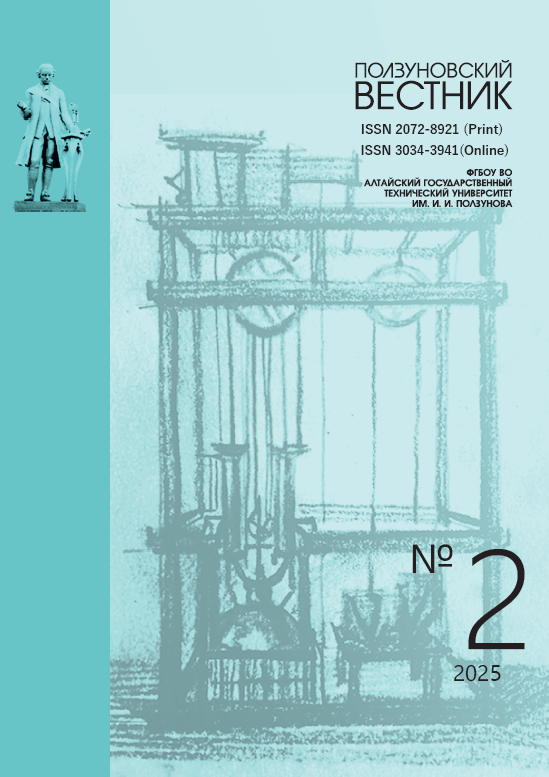INFLUENCE OF LASER MICROSTRUCTURE ON THE STRUCTURE AND PROPERTIES OF THE SURFACE LAYER OF PARTS MADE OF 30KhGSA STEEL
YLCJY
DOI:
https://doi.org/10.25712/ASTU.2072-8921.2025.02.022Keywords:
30KhGSA steel, laser microstructuring, laser exposure zone, white layer, microhardness, structureless martensite, carbon concentration, Soret effectAbstract
The paper investigated the effect of laser microstructuring modes with a continuous fiber laser (equipped with a galvanoscanator) on changes in the structure, phase composition, carbon content and physico-mechanical properties (microhardness, residual stresses) of the surface layer of parts made of hot-rolled medium-alloy steel grade 30KhGSA. The surfaces were subjected to laser microstructuring immediately after gas laser cutting and subsequent mechanical grinding, which was carried out in order to remove the zone of gas laser thermal exposure. When setting different modes of laser microstructuring, the power of laser radiation, the speed of movement and the density of the laser beam fill, the oscillation frequency of the galvanoscanator, the number of passes of the laser beam along the x and y axes were varied. It was found that as a result of laser microstructuring, a hardened white layer consisting of structureless martensite and having an increased carbon content of the order of 0,60-0,81%. The microhardness of this layer is 3,8-4,4 times greater than the microhardness of the base metal matrix. The increase in carbon content was associated with the realization of the thermodiffusion effect (Soret effect). It was revealed that the thickness of the white layer is significantly influenced by the speed of movement of the laser beam and the oscillation frequency of the galvanoscanator. The optimal quality of the surface layer is ensured at a laser beam scanning speed of 250 mm/min and an oscillation frequency of 50 Hz, which corresponds to the area of absorption of laser radiation by the treated surface per unit of time, not less than 150 mm2/sec. It is shown that the initial state of the treated surface (after gas-laser cutting, after mechanical grinding) does not lead to significant differences in: structure, microhardness, length of the laser impact zone, after their further laser microstructuring. However, at the same time it is established that laser microstructuring of the surface immediately after gas-laser cutting leads to the formation of residual macrostresses of compression in it with a value of up to - 1702 MPa.
References
Белов П.С. Влияние параметров постобработки на шероховатость поверхности изделий, получаемых методами аддитивных технологий // Вестник МГТУ "Станкин". 2019. №1(48). С.57–61.
Вегера И.И., Голубев В.С. Опыт применения современных методов поверхностного упрочнения на основе лазерной и ТВЧ обработки // В сб.: Современные методы и технологии создания и обработки материалов. В 2-х книгах. Кн. 2. Электотехнологии.; под ред. В.Г. Залесского. Минск, 2021. – С.44–58.
Методы поверхностного упрочнения деталей машин на примере коленчатого вала / М.Р. Фазулзянов, [и др.]. // Современные наука и образование: достижения и перспективы развития: материалы III Национальной научно-практической конференции; под ред. Е.П. Масюткина. Керчь, 2023. – С.100–111.
Табатчикова Т. И. Перекристаллизация и возможность реализации бездиффузионного α→γ-превращения при сверхбыстром лазерном нагреве сталей // Физика металлов и металловедение 2008. Т.105. №3. – С.294–318.
Лазерное и электроэрозионное упрочнение материалов / В.С. Коваленко, [и др.]. М.: Наука, 1986. 276 с.
Влияние режимов лазерной обработки на изменение структуры и механических свойств поверхностного слоя деталей из стали марки 30ХГСА / И. В. Минаев, [и др.]. // Известия Юго-Западного государственного университета. Серия: Техника и технологии. 2023. Т.13. №1. С.73–86. doi.org/10.21869/2223-1528-2023-13-1-73-86.
Миркин Л.И. Рентгеноструктурный контроль машиностроительных материалов. М.: Машиностроение, 1979. 134 с.
Горелик С.С., Скаков Ю.А., Расторгуев Л.Н. Рентгенографический и электронно-оптический анализ. М.: МИСИС, 2002. 360 с.
Новиков И.И., Строганов Г.Б., Новиков А.И. Металловедение, термообработка и рентгенография. М.: МИСИС, 1994. 480 с.
Григорьянц А.Г., Шиганов И.Н., Мисюров А.И. Технологические процессы лазерной обработки: учебное пособие для вузов / под ред. А.Г. Григорьянца. М.: Изд-во МГТУ им. Н.Э. Баумана, 2006. 664 с.
Основы лазерной и газоплазменной обработки сталей / Н.Н. Сергеев, [и др.]. Тула: Изд-во ТулГУ, 2017. 337 с.
Газодинамика лазерной резки толстолистовых металлических пластин непрерывным СО2-лазером / А. В. Зайцев, [и др.] // Вычислительные технологии. 2006. Т. 11. Ч. 1. Специальный выпуск. С.74–83.
Многопараметрическая оптимизация параметров лазерной резки стальных листов / А.Е. Гвоздев, [и др.]. // Материаловедение. 2015. №2. С.31–36.
Распределение остаточных напряжений на поверхности сталей, упрочненных непрерывным CO2-лазером / А.Г. Григорьянц, [и др.] // Металловедение и термическая обработка металлов. 1987. №9. С.45–49.
Оценка влияния параметров режима лазерной закалки на качество поверхности и поверхностного слоя деталей станков (обзор) / С.В. Петроченко, [и др.] // Омский научный вестник. 2024. №1(189). С.56–65.
Downloads
Published
How to Cite
Issue
Section
License
Copyright (c) 2025 Denis S. Klementyev, Igor V. Minaev, Alexander N. Chukanov, Sergey S. Goncharov, Sergey N. Kutepov

This work is licensed under a Creative Commons Attribution 4.0 International License.















 .
. This work is licensed under a
This work is licensed under a 
